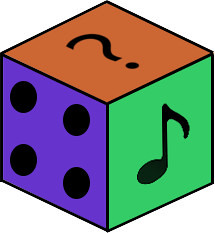On a lazy Christmas afternoon I was noodling in 17TET. After reassuring myself that I suck at music I've decided to turn to maths and game design to feel better about myself. Hence little musical considerations in this post.
I've written a script to generate coprime table for a range of intervals (expressed in half-steps). There are some patterns but the only symmetry is inevitable and completely non-interesting diagonal one. If using two d12 dice there is a bit over one in three chance that the numbers won't be coprime so a reroll (or a player cheating) is necessary for all the notes in scale to be accessible. For other dice the probability is probably similar given somewhat even distribution of coprimes. Moreover I think that deciding whether two numbers are coprime is not obvious for many. So rerolls and and a table, just outright ugly. The situation changes little if we give players an octave for free as you proposed, dice and table are just smaller.
As I already mentioned cards solve all these problems. As a bonus they provide way to weed out some possibly uninteresting interval pairs. There are 11 such pairs for intervals 1 through 6, and 45 for intervals 1 through 12. Taking the idea further, cutting the number of cards down shifts emphasis from a game to an aleatoric music piece. There could be a set of just a few cards dealt to players non randomly based on the range of their instruments. That would probably need some other starting and stopping conditions as target pitch can be hit in just a few steps.
While thinking the player cheating remark turned out to be a useful foreshadowing. What if we accept whatever the dice give us and allow players to cheat a bit? I suspect that using one of 1,5,7 or 11 just once can get you to any target pitch unless a player already has that interval at their disposal. This also can be the gaming element here though at the moment I have no idea how.
We could also use non-standard dice. If one dice has only 1, 5, 7 and 11 (some repeated or omitted (we don't want to deal with d4)) and the other 2,3,4,6,8,9,10,12 we always get a coprime pair at a cost of not all of coprime pairs being possible. For instance a two d6 with 1,1,5,5,7,7 and 2,2,3,3,4,6. I think that the bias towards smaller intervals makes playing easier and more melodic. With two dice one could be rolled just once and the other rolled for each player; the common interval could perhaps add some cohesion.
1 2 3 4 5 6 7 8 9 10 11 12
1 x x x x x x x x x x x x
2 x x x x x x
3 x x x x x x x x
4 x x x x x x
5 x x x x x x x x x x
6 x x x x
7 x x x x x x x x x x x
8 x x x x x x
9 x x x x x x x x
10 x x x x x
11 x x x x x x x x x x x
12 x x x x
